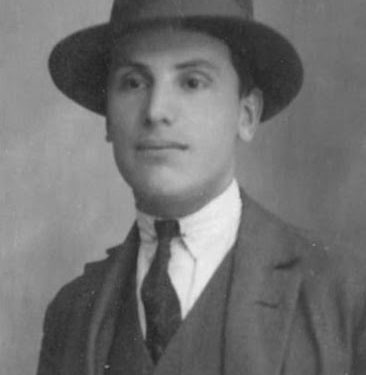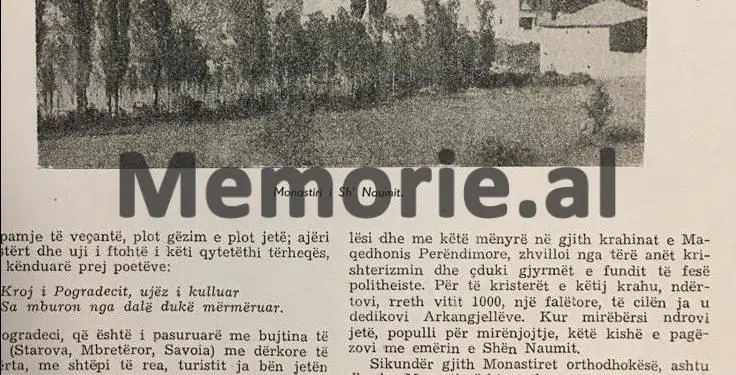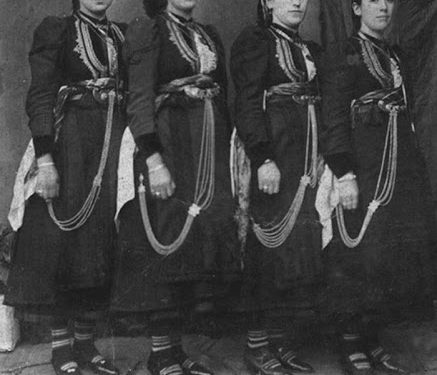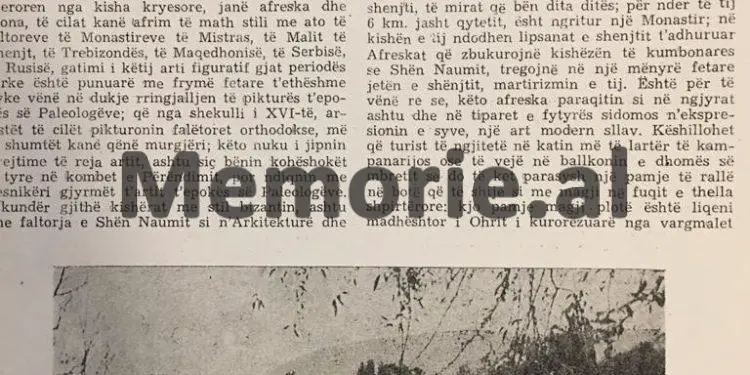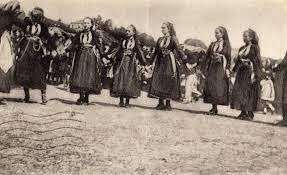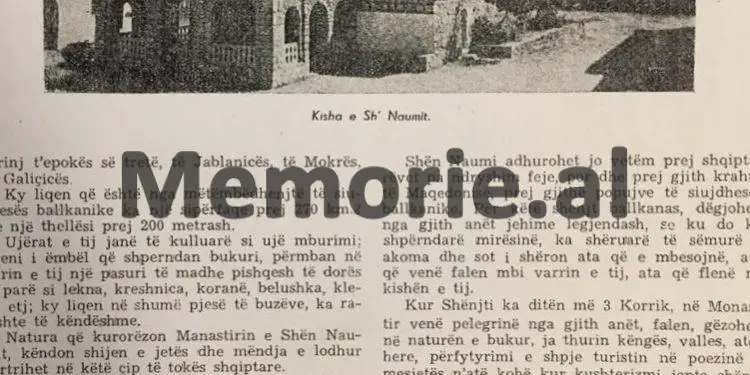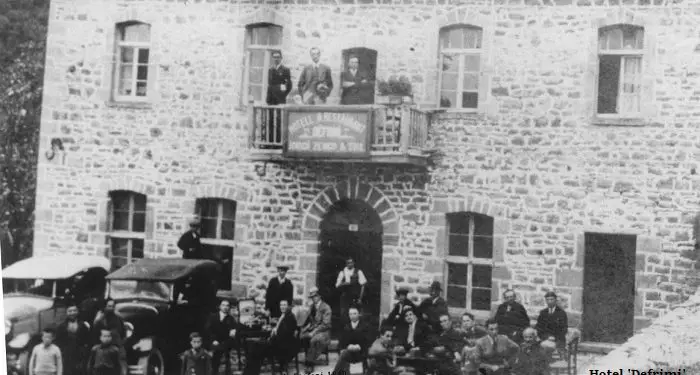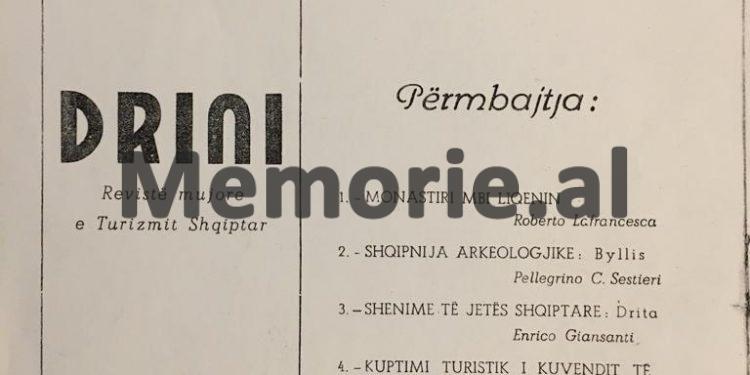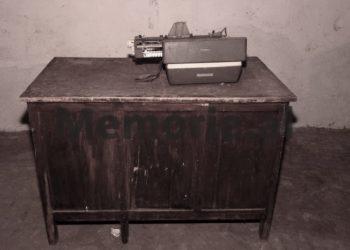Dashnor Kaloçi
Memorie.al publishes two rare and unknown reports on the famous monastery of St. Naum, published in 1942 in the monthly magazine “Drini”, published by the National Tourism Agency in Albania at the time. As described by the Italian researcher of history, Roberto Lafranceska, the visit to that cult object where he was amazed and the report of prof. Petraq Pepo, one of the best connoisseurs of the cultural heritage of Albania in the Monarchy period. The surprise of the Italian journalist for the clothes and folk costumes he saw there, where he was amazed even for that of the village Dardhë, where among other things he writes: “Among all these clothes with the biggest density were the beautiful women of Dardha. Dardha is a small, mountainous village in southern Albania. We immediately noticed them in the whole pile of clothes. All beautiful and magnificently dressed and worthy to be called princesses. One of them even had a small, yellow-haired, golden-eyed, blue-eyed maiden found at the bottom of the endless oceans, dressed in the beautiful costume of the village.
As you leave behind the winding turns of Qafë Thana and suddenly before your eyes as if by magic appear with a fabulous beauty the crystal surface of Lake Pogradec, on the left side of the road, at the foot of a hill, you can see some small houses which are located up to the water’s edge over the lake. It is the village of Lin. Not far from that village, whose inhabitants are best known as skilled fishermen, on a strip of land near the shore of the lake, is the famous monastery of St. Naum. Which has been and remains a cult object of the most frequented not only by Albanians but also almost by most of the peoples of the southern Balkans. Among other things, this is made known by two reports published in 1942 in the monthly magazine “Drini”, published at that time by the National Tourism Institute in Albania, which have as authors, the Italian researcher of history, Roberto Lafranceska and the famous professor from the city of Korça, Petraq Pepo, one of the best connoisseurs of cultural heritage in Albania of those years. In both of these reports, which are mostly study writings on the history of that famous cult object, its great attendance by many Albanian tourists and believers is highlighted. But the time when Albanian believers and tourists flocked to that monastery, already belongs to the past and that thing has remained only in the popular memory since 1943, that place is located outside the political borders of our state. However, these two reports, which we are publishing in full and without any changes, make a retrospective of that period of time, which for 45 years has been unjustly denied to the Albanians of the motherland.
Roberto Lafrancesco’s article in the magazine “Drini”: The monastery on the lake
At the southern end of Lake Pogradec is a monastery. In Albania, everyone knows him, even the one who comes for the first smell receives the news of the existence of a monastery; do you go to Pogradec? There is to be seen a monastery, the monastery of St. Naum! So they ask you and answer you. And after passing the first elbow of Qafë e Thanës, from above, the crystal surface of the lake is visible and the view is stopped once in front of a mountain trail, where the small houses of the beautiful village are located and with a resounding name: Lin, a fishing village. He walks around the shore of the lake until he meets the monastery of St. Naum. The monastery is a bit far but still, you can see it very quickly from that moment it becomes a center of walking and tourist pilgrimage with full fair reasons. One spring day I found myself in the lake. In that Albanian spring that is the longing of the many colors of nature. After a short trip, I happened to be in the city of Pogradec covered with greenery, with beautiful houses. But the goal was the monastery and by car, I always continued my journey beyond the houses of Pogradec. For a part of the road, hindered by the frequent greenery, they lost the appearance of the monastery, like a young bride hiding under her veil of shame. And in front of us descends nothing but the only crowded street on either side of it with buffaloes drowning in the mud. We soon reached the hills, passing one after the other until the last corner, from where, as if by a miracle, the monastery of St. Naum was dueling in front of us, and you returned without waiting for the sight of our fantasy.
“Heaps of visitors on Holy Day”
An Albanian friend accompanied us those days, and we both stayed there all day; and the monastery remains uninhabited all year round, except on the day of the feast of the saint, which is visited by crowds of visitors. The main entrance is made of bronze, right in the middle of the courtyard, surrounded by the monastery buildings designated for the accommodation of friends who visit it once a year, as well as the building of the saint’s tomb. It is a small Byzantine-style building gilded by the sun and rendered by time. In it, the remains of the saint have been laid to rest for ten centuries, after the many fatigues of the sacred religious walks, after preaching for a long time throughout the Balkans the religion of Christ. For centuries, the faces of other saints have preserved his tomb. And on these wall sites is the true soul of the monastery, it is the center where thousands of my pilgrims from all over Albania converge. The elders will talk to you about this pilgrimage performed by their ethnic group. An elderly villager showed me the visits he had made to the monastery in his youth, before emigrating to Romania. “The thieves – the lord told me – never attacked the pilgrims who came and went from the saint, our wives traveled without fear, day and night, without any fear because they respected them.” And as always this year, all Albanians from all over Albania ran to honor the saint for his day, an honor that erupted in a celebration of a national character. The whole monastery was enlivened, enlivened. From the mountains, from the fields, from the villages, from the cities, from the churches, from the mosques, the Albanians ran to St. Naum, with all the means of movement, with cars, with carts, with characteristic boats, on the backs of mules and on foot. in unfinished verses walked the people weighed down by the weight and gifts they brought to the saint, the rich and the poor. And in a short time they multiplied, a river of people burst forth from the courtyard to the small hill where the remains of the saint rest. The vibrant and colorful colors of the different provinces gave a special harmony to the beautiful colors of nature.
“Pear women’s costumes, like ours in Val d’Aosta”
The unlimited number of clothing games from Albanian women in the districts to the elastic and beautiful-looking bears was a range of colors and gorgeous outfits. Among all these dresses with the biggest density were the beautiful women of Dardha. Dardha is a small, mountainous village in southern Albania. We immediately noticed them in the whole pile of clothes. All beautiful and magnificently dressed and worthy to be called princesses. One of them even had a small yellow-haired maiden like gold, with blue eyes as if found at the bottom of the endless oceans, dressed and she is the beautiful costume of the village. A cloth garment where red and black and gold workmanship, on it, wide strings adorn the look. The hair of all, pulled from the back was gathered in a black facolet in the same shape as that of our Val d’Aosta women. With a sleek elegance and elegance, with combing and sleekness, even in the smallest movements, the pear women represented the aristocracy of the holiday, and in none of them would they be able to discern even the slightest hint of absence.
“Beautiful Dardhare Beautiful Dances”
In the small forest, on the shore of the pond, women, and men dancing. From their point of view, the man had the impression that they had performed a religious function. On foot, we caught each other, in a circle, moving out of the body, accompanied by occasional slaps. Gradually, the rhythm of the small orchestra began to diminish, and the dance moves became more distinct, and then they became more and more elegant and graceful. For the entire time of the dance, the expression of the members of the dance had not changed with that clarity that made you think it was a lofty ceremony. And among all those people, one question came to mind? Why is everyone running in this place? Is it just the mystical flame and the faith of all those people that push them to come from so many distant lands, often tired and sacrificed? Albanians have always maintained their faith in the sacred and the history that has from this point of the Albanian land one of the most delicate national claims, they had taken away from Albania the possession of the monastery, and have always come once a year, asking the saint to heal and their spiritual and physical ailments. But as he said earlier, it is another feeling that pushes all that mass of people to be brought from the different provinces of Albania to come and kneel before the tomb of the saint. Albanians love the monastery and the places that surround it and give them gifts; even the air, the sun, the greenery, the tranquility and beauty of this wonderful part of their land. After the gift is given to the saint, they are distributed around it and you are satisfied with the natural beauties. And the feast of St. Naum, in addition to the religious manifestation, is a reincarnation of this land, a return of the homeland that the Albanians have never forgotten even in the darkest days of robins. And they feel so connected to it because for history and tradition that part of the land belongs to the Albanians.
Prof. Petraq Pepo: picturesque Albania, St. Naumi
The beautiful land of Albania, in ancient times and in those new times, has been a bridge, where the civilizations of the Greeks, Romans, Byzantines, where the new religions have entered and passed easily, have crossed; in this way, a part of the people of this country, has embraced since the first centuries the new religion, Christianity, which has left shrines of great value. One of these famous shrines of Albania and the whole Balkan peninsula is the Monastery of St. Naum. We must all recognize this sacred place, we must make it clear that in this way we will enjoy the deep power of the beauty of the country and the powerful power of art and prayer. From Tirana, to go to the Holy Place, you have to walk 152 kilometers; nature, which crowns this road, is so magnificent that it inspires the treasure of poetic fantasy, that the spirited tourist will pass through high mountains with long oaks, through the valleys of laughter with clear rivers, through small fields with lots of flowers. The tourist will leave Tirana, cross the neck of Kraba (height 586 meters), and after making 55 km. will arrive in Elbasan; this city, which was built where the ancient Scampa was, has old mosques, has the characteristic church of St. Mary with a very beautiful iconostasis, has the castle that was built in the time of Sultan Mehmed II, the most opponent strict Skanderbeg.
“Elbasan-Pogradec-St. Naum, 97 km”.
Leaving Kristoforidhi’s birthplace, the tourist travels 90 km. through the sweet valleys, which divide the mountain range of central Albania, the enlightened traveler, with gas in his soul, inspired by the wild nature full of greatness, by the cheerful livestock of sugar, arrives in Pogradec with songs in the mouth of the great Naim:
“Peaks, hills, cliffs and forest green,
You will sing the cattle that you keep and feed,
Blessed are you, O my people!
Pogradec, a small town of about 3,000 inhabitants, is located 693 meters above sea level, built on the surface of Lake Ohrid, equipped with a beautiful sand dune, crowned with mountains and green hills, Pogradec presents a view special, full of joy and full of life; the pure air and the cold water of this attractive city have been sung by the poets:
“Kroi i Pogradecit, clear water
How much he protects from going out by muttering.
Pogradec, which is rich in good inns (Starova, Royal, Savoia), with clean decorations, new houses, makes the tourist’s life pleasant because here he finds two benefits; on the one hand the clear waters of the lake, on the other hand, you are magically attracted by the tall oak mountain.
“Legend of painting on the main gate”
Like all Orthodox monasteries, this monastery is surrounded by high and strong walls. The bright tourist will look over the main gate at a painting, which represents a field where a farmer releases the field with a ka under one yoke on one side and a bear on the other. This painting is explained by this legend: It is said that: at the time when the righteous man Naumi was alive, a bear came down from Mali Thatë, ate a ka that served to plow the field of the Church; then the saint turns to the bear, warns him, and rebukes him so beautifully that the bear repents, and heads, and enters under the yoke himself, taking his place, and bringing the service of the wretched ox. As it passes through the large gate, it enters the courtyard where a fountain is located and where the church of the monastery is erected in a beautiful and magnificent way. Every Orthodox monastery has its own church in the middle of the courtyard. Based on the architecture of these churches, the material used for the construction, as well as some frescoes, we are of the opinion that this shrine was erected after the 10th century, i.e. enters the group of those Orthodox shrines of Albania built before the XIV century which presents the beautiful Byzantine style but with Serbian influence. Bulgarian, Romanian, sometimes Russian. Like many other churches, the shrine of St. Naum consists of a cathedral, the main church, and the hierarchy. The main church has a very deep dome and the vestibule is a dome decorated with religious frescoes. Inside the artichoke are two columns, which must have remained from the construction of the older church. To the south, to the right of the, is the tomb of St. Naum; generally, on this tomb, the pilgrims make prayers and give precious gifts. There are various religious frescoes around the walls where the tomb is located, especially some of them depicting the details of the legendary cow and shepherd. Frescoes in general, icons on the walls and especially those that adorn the iconostasis, i.e. of that part that separates the hierarch from the main church, the frescoes, and icons which have a great style approach to those of the shrines of the monasteries of Mistra, the Holy Mountain, Trebizond, Macedonia, Serbia, Russia, cooking this figurative art during the Turkish period was worked with a special religious spirit, noting the revival of the painting of the Paleolithic era; since the sixteenth century, artists who painted Orthodox shrines, most have been monks; these did not give new directions to art, as their contemporaries did in the nations of the West, but faithfully followed in the footsteps of the art of the Paleolithic era.
“Decorated facilities that make up the monastery”
Like all Byzantine-style churches, St. Naum’s shrine, both architectural and pictorial, is magnificent and requires a glow of color. All around this church are built the dwellings of the religious and monks who serve the Holy Monastery; other living quarters also serve for relaxation, sleeping for travelers, pilgrims, and those who, with a longing, want to spend the summer in this beautiful and blessed place. Near the waiting room, there is a hat and the room of Alexander, the former King of Yugoslavia. In one corner of the courtyard, a bell tower has been set up in the full shade, which on the first floor is decorated with a beautiful hat, dedicated to St. John Vladimir; the tourist is advised to visit this church attentively; this saint is much loved in Central Albania; the inhabitants of Elbasan and the highlands tell of the miracles of this saint, the good he does day by day; in his honor, 6 km. outside the city, a monastery has been erected; in his church are the lipases of the worshiped saint. The frescoes that adorn the chapel of St. Naum’s bell tower show in a religious way the life of the saint, his martyrdom. It is noteworthy that these frescoes are presented in both colors and facial features, especially in the expression of the eyes, a modern Slavic art. It is advisable for the tourist to climb to the top floor of the camper or to the balcony of the king’s room that he will consider a rare sight in the world to shoot as if by magic in the deep spiritual powers; this magnificent view is the magnificent Lake Ohrid crowned by the new mountain ranges of the third era of Jablanioca, Mokra, Galica.
“Ohrid’s stunning lake with rich fauna”
This lake, which is one of the largest in the Balkan Peninsula, has an area of 270 km. square and with a depth of 200 meters. Its waters are as clear as the waters of boasting; The sweet lake that spreads beauty contains in its bosom a great wealth of first-hand fish, such as lekna, kreshnica, korana, belushka, klena, etc. This lake, in many parts of the lips, has pleasant sandstones. The nature that crowns the Monastery of St. Naum sings the taste of life and the tired mind is renewed in this chip of the Albanian land. The nearest walk that man will make coming out of the shrine is the ajazma, the blessed water; here the believer for faith wets his forehead to protect him from all evil, drinks a little water, and as opposed to Rome in Fontana di Trevi, throws some money, so that God may grant him another walk in this blessed place. Two steps further emerges a very small lake, a diamond of lakes and of poetry itself, nourished by the footsteps of the Dry Mountain; The mother of these boasts is Lake Prespa, which climbs 130 meters above Ohrid’s ay. Dry Mountain Stone enters the nature of soft limestone rocks; the waters of Lake Prespa, cross the mountain and flow in the form of boasting into the small and beautiful lake, and from here they form at the foot of the Monastery, the beginning of the Drin that the poet sings.
Professor Pepo: All the peoples of the Balkans come and pray there, St. Naum is worshiped not only by Albanians
In his report on the monastery of St. Naum, which is mostly a study article on the distant and recent history of that famous cult object worshiped not only by Albanians but almost by all the peoples of the southern Balkans, History scholar, Professor Petraq Pepo, has also made a description showing some of the legends that have been passed down through the generations about the past of that monastery. In this regard, he wrote, among other things: “St. Naum is worshiped not only by Albanians without change of religion, but also by the whole wing of Macedonia, by all the peoples of the Balkan Peninsula. legends, where he has distributed kindness, where he has healed the sick and still today heals those who remain, those who come and pray over his grave. Those who sleep in his church. When the Saint has the day on July 3, in Belgrade they put the pilgrimage from all sides. They pray, rejoice in beautiful nature, weave the song, dance, then, imagine and lead the tourist into medieval poetry at a time when Christianity was giving saints; here he understands even better the past centuries of Balkanism. All the good things come together and surround St. Naum, the love of the peoples of Balkan art, the mountains, the forests, the lake, the joy of the pilgrims, and all this together inspires high ideals, captures the imagination, leads it to the realm of productive activity, to the realm. of poetry, in the field of Naim’s work: Livestock and Agriculture:
“When the cold water comes, the north wind blows in the summer
The flower blooms with a lot of gas and with beauty and smell
Where the shepherd blows the trumpet, the cattle graze,
Where the goat is bored with the bell, I have my mind there “.
Professor Pepo: “This is how the monastery of St. Naum was founded”
In his report on the Monastery of St. Naum published in the monthly magazine “Drini” published by the National Tourism Agency in Albania of 1939-1943, Professor Petraq Pepo, has made a brief description of the history of the founding of that monastery famous who since 1943, is outside the political borders of Albania. Regarding this, among other things, Lafranceska states: “Passing 7 km from Poradec. on the shores of the lake, it reaches the Monastery of St. Naum. The founding of this Holy Monastery is lost in the mists of the Middle Ages. In the bay of the Albanian land, there are 71 Orthodox Monasteries, a large part of which were built before the 16th century, i.e. during those centuries when in the heart of the Byzantine period a Balkanosmos developed, at a time when in Albania as a result of various invasions left their mark Bulgarians, Normans, Despotate of Epirus, Serbs, Albanian princes and all have the influence of the spirit of Byzantine art. The monastery of St. Naum is proud to bear this spirit. St. Naum, Priest, and his companion Clement, bishops endowed with the gifts of the Holy One, have wisely followed the path of Cyril and Methodius to develop sternness among the peoples where paganism still stood. St traces the last traces of the polytheistic religion. For the Christians of this wing, he built a shrine around 1000, which he dedicated to the Archangels. When I passed away, the people, for the sake of gratitude, baptized this church with the name of St. Naum ”./Memorie.al




